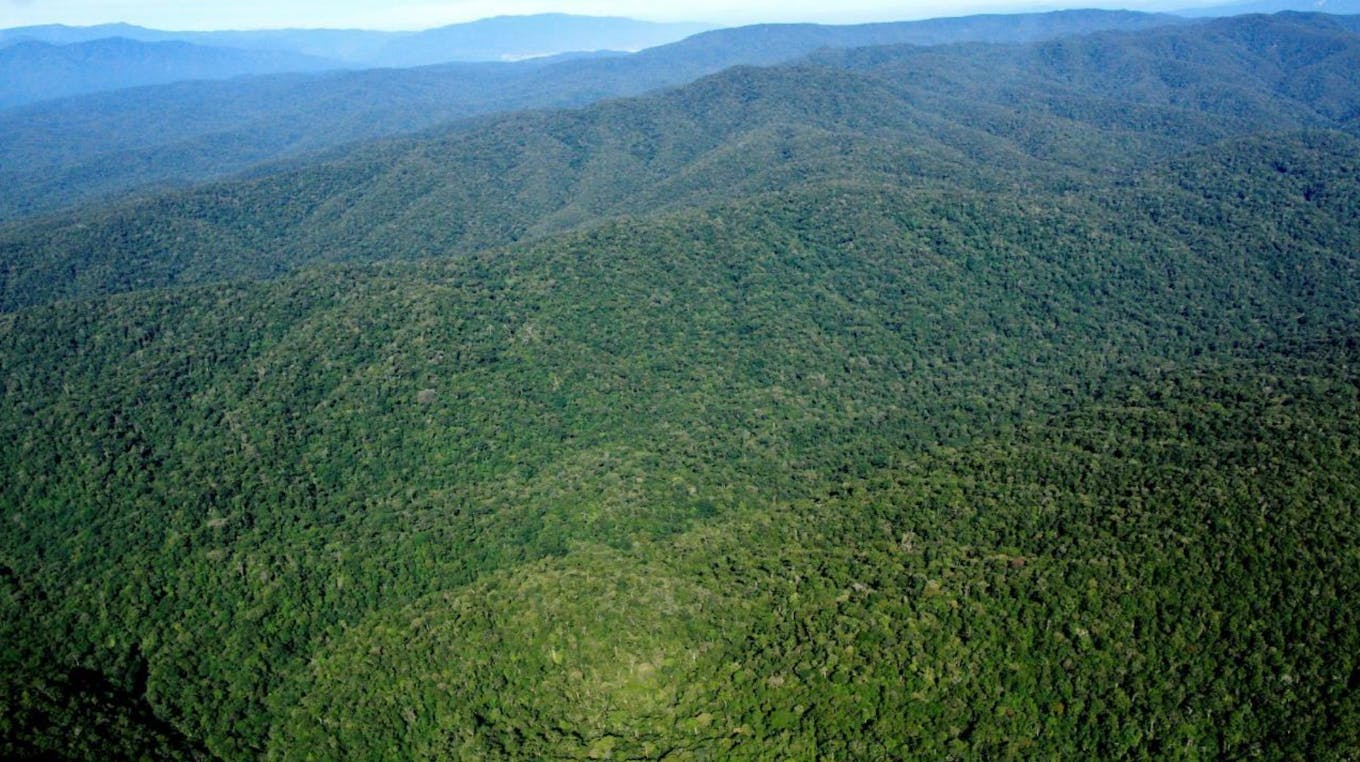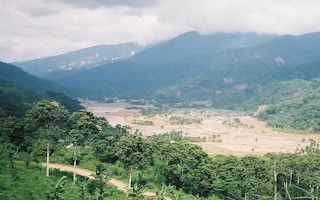When he was growing up, Rudi Putra, a biologist from Aceh Tamiang, a regency that lies within the vast Leuser rainforest on the Indonesian island of Sumatra, would swim and fish in the river near where he lived.
But at some point during the 1980s, the river was polluted by chemicals used to grow palm oil and the fish all but disappeared. “It was traumatic to see thousands of dead fish in the river I’d love to swim in,” said Putra, who has since committed his life to conservation.
Over the years, palm oil plantations and loggers have eaten into about one-fifth of the Leuser Ecosystem, famously the only place on Earth where tigers, elephants, rhinos and orangutans live in the same area.
The end of the Aceh independence movement and the recovery from the devastating 2004 tsunami heralded a period of agricultural expansion in the region. The stripping of tree cover to make way for plantations, particularly in lowland areas, caused landslides and flooding. Land disputes between resource companies and local communities were common.
But the ever-optimistic Putra, who was awarded the Goldman Environmental Prize in 2014 for his efforts to combat illegal logging and palm oil planters, has put his faith in a forest conservation and land-use model he believes can save the Leuser and other tropical forest landscapes like it.

The Leuser Ecosystem covers more than 2.6 million hectares and is one of the richest expanses of tropical rain forest in Southeast Asia. It is the only place on Earth where tigers, elephants, rhinos and orangutans live in the same area. Image: Leuser Conservation Forum
The landscape approach
The “landscape approach” is a method for conserving forests and building sustainable supply chains by managing entire landscapes. It is seen as complementary to the certification of individual businesses, projects or estates to protect ecosystems.
Also known as the jurisdictional approach to land management, it could help companies that source palm oil, rubber, coffee and other commodities reduce the risks of deforestation from the region as increasingly stringent requirements for trading in forest-risk products, such as the European Union’s deforestation regulation (EUDR), are being adopted.
The concept emerged from the realisation that companies could not eliminate deforestation from their supply chains without working with other stakeholders, said Leony Aurora, landscapes and partnerships lead for Tropical Forest Alliance (TFA), a non-profit that recently published a study on the landscape approach in the palm oil sector.
For example, the Consumer Goods Forum, a group of the world’s biggest consumers goods companies, missed a target set in 2010 to be deforestation-free by 2020 and has had to radically rethink how it tackles deforestation beyond individual supply chains.
In the case of Aceh Tamiang, the landscape approach saw Putra’s organisation, the Leuser Conservation Forum (FKL), team up with fellow non-governmental organisation Inisiatif Dagang Hijau (IDH) – which initiated the programme – palm oil company Musim Mas and consumer goods firms PepsiCo and Unilever to support the district government in a programme known as Pusat Unggulan Perkebunan Lestari (PUPL), or Centre of Excellence.
Key to making the programme work has been training smallholder palm oil farmers, who are often blamed for deforestation and starting fires to clear land because they lack the resources and knowhow to farm sustainably, and tend to manage low-yielding plantations as a result.
Musim Mas established a “train the trainers” Smallholder Hub in Aceh Tamiang in 2020, to train government agricultural officers in sustainable agricultural practices in line with No Deforestation, No Peat, and No Exploitation (NDPE) principles, so that they could pass on these skills to independent smallholder farmers in the areas they administer.
Around half of Aceh Tamiang’s 11,000 smallholders have now been trained in sustainable farming, and a similar number now has a land title which enables them to attain Roundtable on Sustainable Palm Oil (RSPO) or Indonesian Sustainable Palm Oil (ISPO) certification, which in turn gives the farmers better access to global markets.
Most smallholders do not have the capacity to meet international standards like the upcoming EUDR rules, because they lack the resources to meet the EUDR’s traceability requirements, but having a land title is an important step towards accessing European markets, said Rob Nicholls, general manager of programmes and projects at Musim Mas, who runs the Smallholder Hubs programme. The EU has yet to determine whether the landscape approach will give forest-risk commodities access to European markets.
Musim Mas has no operations in Aceh, and the region makes up only 6 per cent of the company’s total sourcing area. But as the Leuser is a high conservation area, and the firm sources from suppliers operating near the forest, the company wanted to invest in capacity-building to reduce forest-loss risk.

Government agricultural officers being trained in how to train smallholders to farm sustainably. Image: Musim Mas
The programme has helped to boost productivity for smallholders in the regency. “Previously, smallholder productivity was very low, and many smallholders encroached into the forest,” said Nassat Idris, country director of IDH Indonesia.
As smallholders had little contact with palm oil companies, their fresh fruit bunches would take a long time to reach the mills, he said. Now though, as more smallholders join the landscape-based programme, they supply directly to the mills, so get a better price for their crops.
Funding from the project has helped Putra’s team work on restoration projects in areas where forests have degraded – to date, 500 hectares of forest have been restored, with the aim to restore 10,000 ha over the next few years – and pay for monitoring systems to detect deforestation and the 400 wildlife rangers on his staff.
The programme has played a role in reducing deforestation in the region. Last year, 40 ha of forest was lost in Aceh Tamiang district, the lowest rate of deforestation in Aceh province. This compares to 400 ha per year just three years ago. In the wider Leuser Ecosystem, the rate of forest loss has fallen too. In 2015, the Leuser lost 1,141 ha of forest per month. In 2021, the monthly forest loss rate was 396 ha.
“No one believed this iniative would work,” said Putra. “Usually conservation or smallholders projects fail after a few years. But this programme is still going and is expanding.”
Trust and time
Making the landscape approach work is not easy, as such initiatives involve numerous moving parts and multiple stakeholders. The biggest issue, according to numerous experts interviewed for this story, is trust – particularly in a region where conflict between corporations, the community and government has been common in the past.
“If a company goes straight to the community, it would be hard to convince them [of the benefits of the initiative],” said Idris. “They will be suspicious as to why a company wants to go to a village and support farmer training.”
For this reason, it is crucial that the local government leads the initiative. “The government needs to convince the community that there are livelihoods benefits to gain,” he said.
Another issue is time. Aurora of Tropical Forest Alliance said that it takes time for the various stakeholders involved to align their objectives and agree on outcomes.
“Companies often want to see results quickly, as they are evaluated annually. Stakeholders must accept that the goals of the various parties may be different,” she said. “It requires nuance and the understanding that not all is black and white.”
Scaling the landscape approach
Despite the challenges, the concept is becoming more common as companies look for proven ways to weed deforestation out of their supply chains. In 2022, 38 companies disclosed engagement with palm oil landscape initiatives to carbon measurement nonprofit CDP, up from 17 companies in 2021.
This number is expect to grow. In 2022, 32 companies reporting to CDP said they were planning to engage at landscape scale for palm oil in the next two years, according to TFA’s study.
Companies, NGOs and governments are recognising that the landscape approach is needed to manage water levels to improve peatland management, which cannot be achieved at the farm level, and helps to ensure that the implementation of NDPE policies does not exclude smallholders.
Can the concept work anywhere? There is no single recipe for making the landscape approach work, said Nicholls of Musim Mas. The blend of financing combined with strong on-ground support and collaboration was the key to Aceh Tamiang project, which could serve as a model for other districts to follow, he said.
“Every region will have its unique needs, challenges and stakeholders. Engagement with local and district governments, smallholder associations, and other palm oil companies and off-takers is essential. This avoids duplication of efforts and creates capacity for the long-term,” Nicholls said.













